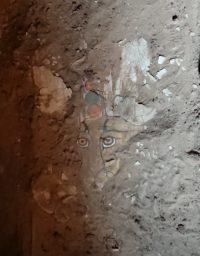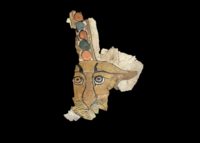 The intense stare of a leopard painted on a fragmented wood sarcophagus lid has been virtually restored. The remains of the sarcophagus lid were discovered in a 7th century B.C. tomb by the Egyptian-Italian Mission at West Aswan in January of 2019.
The intense stare of a leopard painted on a fragmented wood sarcophagus lid has been virtually restored. The remains of the sarcophagus lid were discovered in a 7th century B.C. tomb by the Egyptian-Italian Mission at West Aswan in January of 2019.
The leopard was a symbol of strength and determination in ancient Egypt. When the sarcophagus was intact, the face of the large cat painted on the acacia lid corresponded with the head of the deceased. The effigy of the powerful animal would have helped the individual on his journey to the afterlife.
 With so few fragments in fragile condition, the image on the lid of the sarcophagus was reconstructed virtually before it was physically reconstruction. It is cleaned and pieced together, but its brilliant colors are true to life and have not been digitally enhanced.
With so few fragments in fragile condition, the image on the lid of the sarcophagus was reconstructed virtually before it was physically reconstruction. It is cleaned and pieced together, but its brilliant colors are true to life and have not been digitally enhanced.
The necropolis on the west bank of the Nile is comprised of about 300 tombs, some dug into the hill, some underground, that were in use from the 7th century B.C. through the 3rd century A.D. Last year, the team unearthed  a two-chamber tomb with 35 mummies, including some of small children, numerous funerary objects, mummification supplies (jars of bitumen, white cartonnage blanks ready to be painted and an intact palm wood stretcher with linen strips that was used to transport the mummies into the chamber.
a two-chamber tomb with 35 mummies, including some of small children, numerous funerary objects, mummification supplies (jars of bitumen, white cartonnage blanks ready to be painted and an intact palm wood stretcher with linen strips that was used to transport the mummies into the chamber.
In the chamber next to the leopard sarcophagus, archaeologists discovered a small vessel containing organic vegetal remains. Analysis has identified those remains as pine nuts, an extremely rare find in Egyptian archaeology. The seeds of the Mediterranean umbrella pine are not native to Egypt and must have been imported.
“We like to imagine – comments [professor of Egyptology of the State University of Milan Patrizia] Piacentini – that the people buried in the tomb of Aswan loved this rare seed, so much so that their relatives placed a bowl next to the deceased that contained them so that they could feed on them for eternity.”
